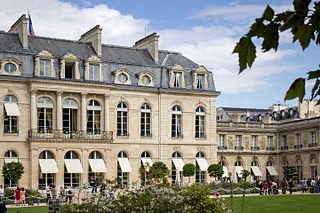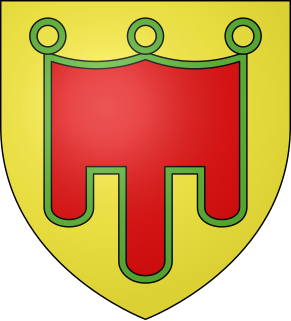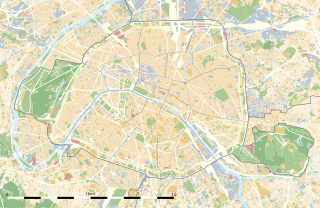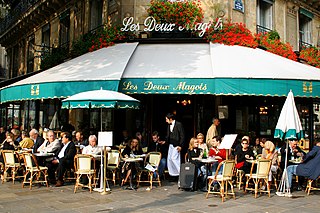
The University of Paris, metonymically known as the Sorbonne, was a university in Paris, France, active 1150–1793, and 1806–1970.

Étienne Baluze was a French scholar and historiographer, also known as Stephanus Baluzius.

The Élysée Palace is the official residence of the President of the French Republic. Completed in 1722, it was initially built for Louis Henri de La Tour d'Auvergne. It was used as the office of the French President for the first time in 1848. The current building contains the presidential office and residency, as well as the meeting place of the Council of Ministers. It is located near the Champs-Élysées in the 8th arrondissement of Paris, the name Élysée deriving from Elysian Fields, the place of the blessed dead in Greek mythology. Important foreign visitors are hosted at the nearby Hôtel de Marigny, a palatial residence.

The Hôtel de Matignon is the official residence of the Prime Minister of France. It is located in the 7th arrondissement of Paris, France. The address of Hôtel de Matignon is 57 rue de Varenne, Paris. "Matignon" is used as a metonym for the governmental action of the Prime Minister of France.

Louis Joseph de Bourbon was Prince of Condé from 1740 to his death. A member of the House of Bourbon, he held the prestigious rank of Prince du Sang.

Panthéon-Assas University, also referred to as Assas [asas], Paris II [paʁi dø], or Sorbonne-Assas, is a public university in Paris, France.

Frédéric Maurice de La Tour d'Auvergne, Duke of Bouillon was ruler of the independent principality of Sedan, and a general in the French royal army. Born in Sedan, Ardennes, he was the son of Henri de La Tour d'Auvergne, Duke of Bouillon, Prince of Sedan, and Elisabeth of Orange-Nassau. His brother was the renowned Turenne, Marshal of France. Raised as a Protestant, he received a military education in Holland under his uncles, Maurice of Nassau-Orange, and Frederick Henry, Prince of Orange.
Antoine Dauvergne was a French composer and violinist.

The history of the Auvergne dates back to the early Middle Ages, when it was a historic province in south central France. It was originally the feudal domain of the Counts of Auvergne.

Le Vigan is a commune in the Gard department in southern France. It is a sub-prefecture of the department.

Charlotte de La Motte Houdancourt, Duchess of Ventadour was the governess of King Louis XV of France, great-grandson of King Louis XIV. She is credited with saving Louis XV from the ministrations of the royal doctors when he was ill as a child. She was the Gouvernante des enfants royaux, Governess of the Children of France like her mother, granddaughter, granddaughter in law and great grand daughter.

Jean-Baptiste Descamps was a French writer on art and artists, and painter of village scenes. He later founded an academy of art and his son later became a museum curator.

François-Nicolas Delaistre was a French sculptor.

Charles de Rohan, duke of Rohan-Rohan, seigneur of Roberval, and marshal of France from 1758, was a military man, and a minister to the kings Louis XV and Louis XVI. The last male of his branch of the House of Rohan, he was also the great-grandfather to the duc d'Enghien, executed by Napoleon in 1804. Styled prince d'Epinoy at birth, he became the Prince of Soubise after 1749.

Louis Charles Antoine Desaix was a French general and military leader. According to the usage of the time, he took the name Louis Charles Antoine Desaix de Veygoux.

Louis-Gaston Ganne was a conductor and composer of French operas, operettas, ballets, and marches.

The porte Saint-Antoine was one of the gates of Paris. There were two gates named the porte Saint-Antoine, both now demolished, of which the best known was that guarded by the Bastille, on the site now occupied by the start of Rue de la Bastille in the 4th arrondissement of Paris.

Rue Bonaparte is a street in the 6th arrondissement of Paris. It spans the Quai Voltaire/Quai Malaquais to the Jardin du Luxembourg, crossing the Place Saint-Germain-des-Prés and the place Saint-Sulpice and has housed many of France's most famous names and institutions as well as other well-known figures from abroad. The street runs through the heart of the fashionable Left Bank and is characterised by a number of 'hôtels particuliers' and elegant apartment buildings as well as being bounded by the river at one end and the park at the other. With fifteen buildings or monuments classified as Monument Historique, it has more such listed sites than any other street in the 6th arrondissement.
The public domain consists of all the creative works to which no exclusive intellectual property rights apply. Those rights may have expired, been forfeited, expressly waived, or may be inapplicable.
The Reverend James Wood was a Scottish editor and Free Church minister. He was born in Leith and studied at the University of Edinburgh, living most of his life in Edinburgh. His admiration for Thomas Carlyle and John Ruskin may have contributed to his failure to secure a ministry. Instead he earned a living as a writer. He translated Auguste Barth's Religions of India and edited Nuttall's Standard Dictionary, The Nuttall Encyclopaedia, Warne's Dictionary of Quotations, Bagster & Sons' Helps to the Bible, and a Carlyle School Reader. In 1881 he published anonymously The Strait Gate, and Other Discourses, with a Lecture on Thomas Carlyle, by a Scotch Preacher. He is described by P. J. E. Wilson as " that most conscientious of pedants".
The Nuttall Encyclopædia: Being a Concise and Comprehensive Dictionary of General Knowledge is a late 19th-century encyclopedia, edited by Rev. James Wood, first published in London in 1900 by Frederick Warne & Co Ltd.






















